Art Review: The Very Eye of the Night at Jancar Gallery
- Share via
“The Very Eye of the Night,” a 1958 film by experimental filmmaker Maya Deren (1917-1961), opens with a long, slow pan of the night sky, accompanied by a spare arrangement of percussive notes in a haunting score by composer Teiji Ito. As a plaintive woodwind enters in, ghostly figures—dancers depicted in photographic negative—begin to drift across the stars. For the 15-minute duration of the film, camera and dancers alike move as if cut loose from gravity, tumbling through space at every angle like living depictions of constellations.
Deren’s work is a pleasure to encounter in any context, but particularly when couched in as lovely a tribute as is currently assembled at Jancar Gallery, in a group show that takes the same title as the film. Six female artists were asked by the gallery to contribute a work in response to the film, which is also included on a small monitor. The resulting selection draws out several of Deren’s most prominent themes—dream life, the shifting nature of identity, rhythm and repetition, the fracturing of narrative—and attests to her enduring resonance among younger artists.
Nearly all of the works revolve in some way around the presence or absence of the body. Dorit Cypis’s photographic diptych “Revers-ability,” from 2001, depicts the artist alongside a camera, turning away from her reflection in the mirror of a dance studio. In a clever video called “Down the Line,” Sophie Bird Møller’s strings together clips from black and white films that depict invisible figures (as in, the Invisible Man) donning or removing items of clothing.
Anne Colvin’s video “The Study” echoes Deren most directly, collaging fragments of figures from another film, “Ritual in Transfigured Time,” in a sensual, violet-tinted, slow motion meditation.
Elizabeth Tremante’s “Captivity Narrative,” a small suite of paintings, and Tricia Lawless Murray’s “Solar Annulus,” a trio of small wooden crates that house surreal and vaguely salacious dioramas viewable through a small peep hole, both suggest characters adrift in a dream landscape.
The most touching of works is an hour-long video by Micol Hebron, projected in the gallery’s basement, in which Hebron and the artist Michael Hanson face one another in profile. Floating, like Deren’s dancers, against images of the solar system, they go back and forth asking one of two questions: “Who are you?” and “What do you want?” The one-line, clearly improvisational answers span the emotional spectrum of partnership, from glib to erotic to tender to existential. (“I want to slam dunk a basketball.” “I want to abolish capitalism.” “I want your happiness.” “I want to know what to do with my thoughts.”) It is a work of physical and—what’s far more rare—emotional endurance, with a sincerity that is as uncomfortable, in moments, as it is engrossing. It is the unabashed heart of an already stirring exhibition.
Jancar Gallery, 961 Chung King Road, Los Angeles, (213) 625-2522, through July 28. Closed Sunday through Tuesday. www.jancargallery.com
More to Read
The biggest entertainment stories
Get our big stories about Hollywood, film, television, music, arts, culture and more right in your inbox as soon as they publish.
You may occasionally receive promotional content from the Los Angeles Times.










